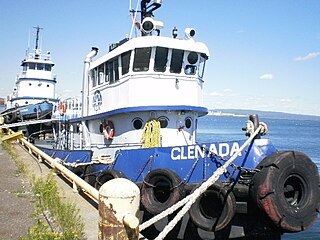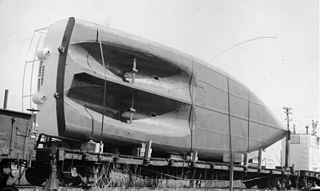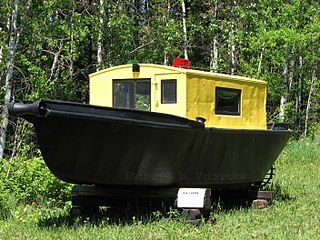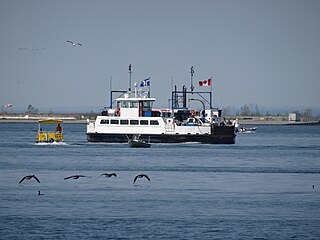Related Research Articles

A tugboat or tug is a marine vessel that manoeuvres other vessels by pushing or pulling them, with direct contact or a tow line. These boats typically tug ships that cannot move well on their own, such as those in crowded harbours or narrow canals, or those that cannot move at all, such as barges, disabled ships, log rafts, or oil platforms. They are powerful and durable for their size. Some are ocean-going, some are icebreakers or salvage tugs. Early models had steam engines, and modern ones have diesel engines. Many have deluge guns, which help in firefighting, especially in harbours.

Hercules is a 1907-built steam tugboat that is now preserved at the San Francisco Maritime National Historical Park in San Francisco, California.

Arthur Foss, built in 1889 as Wallowa at Portland, Oregon, is likely the oldest wooden tugboat afloat in the world. Its 79-year commercial service life began with towing sailing ships over the Columbia River bar, and ended with hauling bundled log rafts on the Strait of Juan de Fuca in 1968. Northwest Seaport now preserves the tug as a museum ship in Seattle, Washington.

Normac is a floating restaurant boat that was launched as a fire tug, named the James R. Elliot. She was built at the Jenks Shipbuilding Company in Port Huron, Michigan, in 1902.

William Lyon Mackenzie, built by Russel Brothers, named for Toronto's first mayor William Lyon Mackenzie, is a fireboat for the Toronto Fire Services (TFS). It was built in 1964 with a modified Tugboat hull to provide marine fire fighting as well as icebreaking capabilities. In 2004 the fireboat was refurbished and it is expected to be in service until 2037.

Luna is a historic tugboat normally berthed in Boston Harbor, Massachusetts. Luna was designed in 1930 by John G. Alden and built by M.M. Davis and Bethlehem Steel. She is listed on the National Register of Historic Places and is a U.S. National Historic Landmark. In 1985, the Luna was designated as a Boston Landmark by the Boston Landmarks Commission.

Marine Transportation Services (MTS) formerly Northern Transportation Company Limited (NTCL) is a marine transportation company operating primarily in the Mackenzie River watershed of the Northwest Territories and northern Alberta, and the Arctic Ocean using a fleet of diesel tug boats and shallow-draft barges. NTCL filed for bankruptcy in 2016 and its assets were acquired by the Government of the Northwest Territories later that year.
Alligator boats were a type of amphibious vehicle used in the forestry industry throughout Ontario, Quebec, the Maritime provinces of Canada and the northern United States from the mid-19th century to the beginning of the 20th century. These boats were so named because of their ability to travel between lakes by pulling themselves with a winch across land. Alligators served as "warping tug". They towed log booms across lakes and then portaged themselves using a winch to the next body of water. The rugged, steam-powered tugs were one of the pioneers in the mechanization of the forest industry in North America.

The Glen-class tugs were a class of tugboats of the Royal Canadian Navy built during the Second World War. There were three designs of the tugboat; two were of steel-hulled construction and the other was wooden-hulled. Of the 20 of the class built, 16 were of the steel-hulled type; 11 built by Russel Bros. of Owen Sound, Ontario and 5 by Canadian Dredge & Dock Co., Kingston, Ontario. Of the four wooden-hulled type; three were built by McKenzie Barge and Derrick, Vancouver, British Columbia, and one by LeBlanc Shipbuilding, Weymouth, Nova Scotia. All but one – Glendyne – were sold into commercial service after the war.

Foss Maritime, often referred to as Foss Tugging, is an American shipping company. The company was founded in 1889 by Thea Foss (1857–1927) and her husband Andrew Foss. The company is now the largest tug and towing concern on the west coast of the United States.

Glenada is an ex-Canadian navy tugboat that was launched in 1943. Glenada was built by Russel Brothers Limited in Owen Sound, Ontario. It is one of twenty 1943 Glen-class tugs, eleven of which were built by the Russel Brothers Company. When it served for the Royal Canadian Navy the official number for this boat was (W30) 177886 and the Canadian Navy number was 534. The Glen-class tugs were made in two designs ; Glenada is an "A" design, with a longer main deck house, extending aft over the engine room, and uniform height bulwarks from forward to aft. A lifeboat is mounted on the bridgedeck aft of the stack. Glenada was originally powered by one Vivian 320 hp (240 kW) 8-cylinder diesel.

The Radium Express is a Russel Brothers tugboat operated by the Northern Transportation Company. The vessel was built in Owen Sound, Ontario, disassembled, and then shipped by rail to Waterways, Alberta, which was then the terminus of the North American railway grid.

M/V Robert W. is a tugboat that was built by the Russel Brothers Ltd. shipbuilding company in Owen Sound, Ontario, in 1948. The tug is 60 feet long, 16 feet wide, 8 feet 4 inches in depth, and of 48.5 gross tons. It was originally powered by two Cummins NHMS 6-cylinder marine diesel engines originally producing 175 hp each but has been repowered with 2 cummins model NT380M marine engines producing approximately 400 BHP each; the tug originally had a Sheppard 32-volt DC diesel generator for auxiliary power but has been replaced in the mid-1990s with a Lister Diesel model ST2 2-cylinder air-cooled diesel 120-volt AC generator. It was built in 1948 for the Long Lac Pulp & Paper Co. Ltd in Toronto, Ontario, until purchased by Thunder Bay Marine Services in Thunder Bay, Ontario, in 1990. In 2 locations on the Robert W. there are factory brass plaques that state the vessel is boat number 791, length is 60 feet, beam is 16 feet, and year 1948.

SS Brulin was a lake freighter that worked the North American Great Lakes routes from 1924 to 1960. She was renamed Outarde in 1939, and James J. Buckler in 1960, shortly before she ran aground and sank during salvage operations. Brulin was built by Palmers Shipbuilding and Iron Company, Hebburn-on-Tyne and launched on 31 July 1924, for the Montreal Forwarding Company. She was built to the maximum dimensions of the canal locks that preceded the St Lawrence Seaway.

'Brompton Caribou' is 28 feet 6 inches long, 7 feet 6 inches wide and has a depth of 2 feet 9 inches boat commonly known as a "Gator Tug", or "Winch boat" made by the Russel-Hipwell Engines Company in 1955 and is hull number 1058. It is made with a welded 3/16" steel hull in the clinker configuration and a cabin made of 18 gauge steel. It has a cable steering system with a plate steel rudder, 26" diameter Propeller with a rather heavy duty shield around the prop made of round bar to shop logs and debris from damaging the propeller, English made Lister model FR4 4 cylinder water-cooled diesel engine producing 36 hp at 1,800 rpm and a Twin Disc model MG-61 reversing marine gearbox with a 3:1 gear ratio. This boat also originally had a Russel-Hipweel winch, model W-434 that was driven by a PTO on the front of the engine but it has since been removed. The standard models have a simple rectangle cabin with a large sliding windows on both the port and starboard sides, a smaller sliding window and a door that opens to the inside on the front, and a little sliding door on the back of the cabin. They usually have the exhaust pipe going out through the side of the hull approximately a foot below the bulwarks on an angle facing aft, but many have had the pipe removed and installed going up through the roof of the cabin.

The Type V ship is a United States Maritime Commission (MARCOM) designation for World War II tugboats. Type V was used in World War II, Korean War and the Vietnam War. Type V ships were used to move ships and barges. Type V tugboats were made of either steel or wood hulls. There were four types of tugboats ordered for World War II. The largest type V design was the sea worthy 186-foot (57 m) long steel hull, V4-M-A1. The V4-M-A1 design was used by a number of manufacturers; a total of 49 were built. A smaller steel hull tugboat was the 94-foot (29 m) V2-ME-A1; 26 were built. The largest wooden hull was the 148-foot (45 m) V3-S-AH2, of which 14 were built. The smaller wooden hull was the 58-foot (18 m) V2-M-AL1, which 35 were built. Most V2-M-AL1 tugboats were sent to England for the war efforts under the lend-lease act. The Type V tugs served across the globe during Work War II including: Pacific War, European theatre and in the United States. SS Farallon and other Type V tugs were used to help built Normandy ports, including Mulberry harbour, on D-Day, June 6, 1944 and made nine round trips to Normandy to deliver Phoenix breakwaters.

The Ongiara is a 57-year-old Toronto Island ferry operated by the Parks, Forestry and Recreation Division of the City of Toronto government. The ferry serves the Toronto Islands from a dock at Jack Layton Ferry Terminal in downtown Toronto, Ontario, Canada.

The Radium Cruiser was a Russel Brothers tugboat operated on the Mackenzie River system for the "Radium Line". She was constructed in Owen Sound, Ontario, in 1939, then disassembled and shipped by rail to Waterways, Alberta. Waterways is a river port, and was then the northern terminus of the North American railway grid. Waterways is on the Clearwater River, not far upstream from where the river empties into Lake Athabasca. The waters of Lake Athabasca flow into Great Slave Lake down the Slave River, and then down the Mackenzie River to the Arctic Ocean.

Radium Franklin was a tugboat built in 1951, and operated by the Northern Transportation Company - popularly known as the "Radium Line", because many of their tugboats contained Radium in their name, since they were originally built to haul Uranium ore from Port Radium, on Great Bear Lake. She was retired in 1979, after spending most of her career hauling barge packed with ore, and then briefly serving as a yard tug.
References
- ↑ Barrett, Harry B.; Clarence F. Coons; Ken Armson (2010). Alligators of the North: The Story of the West & Peachey Steam Warping Tugs. Dundurn Press. pp. 133–136. ISBN 978-1-55488-711-8.
- ↑ http://russelbrothers.com/
- ↑ http://russelbrothers.com/
- ↑ http://russelbrothers.com/
- ↑ http://russelbrothers.com/